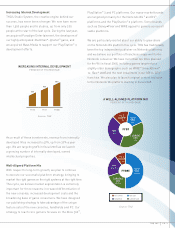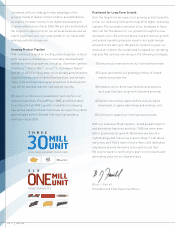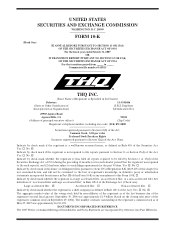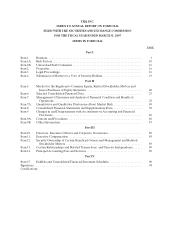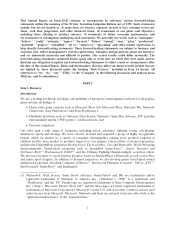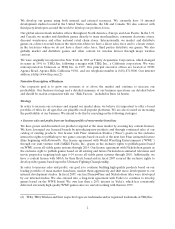THQ 2007 Annual Report Download - page 15
Download and view the complete annual report
Please find page 15 of the 2007 THQ annual report below. You can navigate through the pages in the report by either clicking on the pages listed below, or by using the keyword search tool below to find specific information within the annual report.7
third-party software developers and other independent resources such as artists. We refer to this collective
group of development resources as our Studio System.
We make the decision as to which development resources to usebased upon thecreative and technical
challengesof the product, whether the intellectual property which is being developed into agame is
licensed, an original conceptthat we created, or an original concept created by a third-party developer.
Once we determine where a product will be developed, our internal product development teamoversees
the internalorexternal resources in its design, technical assessment and constructionof each game.
The development cyclefor anew game dependson the platform andthe complexityandscope of the
game. Additionally, when developing an intellectual property into a gamewhich is simultaneouslybeing
made into amotion picture, ourdevelopment schedule is designed to ensure that ourgamesare
commercially availableby themotion picture’s release. The development cycle for console and PC games
ranges from 12-36 months and the development cyclefor handheldgames ranges from 9-24 months.
Thesedevelopment cycles require that we assess whether there will be adequateretailer and consumer
demand foragame well in advanceof its release. Theinvestmentsin such development, priorto reaching
technological feasibility, arerecorded as product developmentexpenses in our consolidated statement of
operations. We had product development expensesof$97.1 million in fiscal 2007,$94.6 millionin fiscal
2006 and $80.1 million in fiscal 2005.
Upon completionof development,each game is extensivelyplay-testedby us to ensure compatibility with
the appropriate hardware systems and configurations and to minimize the number of bugsand other
defects found in the products. If required, we also sendthe gameto the manufacturer for its review and
approval. To support ourproducts after release, we provide online access to ourcustomers on a 24 hour
basis as well as operator help lines during regular businesshours. The customer support grouptracks
customer inquiries, and we use this data to helpimprove thedevelopment and production processes.
Manufacturing
Other than gamesthat we release for sale on PCs or wireless devices, our video gamesaremanufactured
for us by the platform manufacturers or their authorized vendors. We contract with various PC replicators
for the manufacturing of our PC products.
Theplatform game manufacturing process begins with our placing a purchase order with a manufacturer.
We then send thesoftware codeand a prototype of thegame to themanufacturer (together with related
artwork, user instructions, warranty information, brochures and packaging designs) for approval, defect
testing,and manufacture.
We are required by ourplatform licenses to provide astandard defective product warranty on all of the
products sold. Generally, we areresponsible for resolving, at our own expense,any warranty or repair
claims.We havenot experienced anymaterial warranty claims, but there is no guarantee thatwe will not
experience such claims in thefuture.
Marketing and Sales
Our marketingactivities vary depending upon whethera video game titleis basedupon alicensed or an
original property. Alicensed property has pre-existing brand popularity and thus often requires less initial
effortby us to promote. Our marketing efforts for titles based upon original properties beginwell in
advance of atitle’srelease and focus on building positive awareness of ourgame concepts with consumers
and retailers. We conduct consumer and retail research, which provides us with feedbackto position a title
priorto its release. Our public relations promotional activities fororiginaltitlesin fiscal 2007 included
coveragein broadcast, print and online mediatargeting enthusiast, lifestyleand major mainstream outlets.


